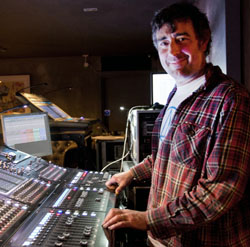
—Dante Virtual Soundcards (DVS) integrate a Mac or Windows computer into a Dante audio network using its Ethernet port, allowing recording and playback of up to 64 channels with any DAW application.
In addition to Nuendo Live, DVS works with most DAWs, including Cubase, REAPER and Logic, as well as consumer applications like iTunes. DVS appears on computers as a Core Audio, ASIO or WDM device.
—The Roland S-RDK driver is a REAC virtual soundcard that allows V-Mixing system users to easily capture up to 40 audio channels from a Roland digital snake directly into most ASIO-based DAWs, including SONAR, Cubase and REAPER, using a single Cat-5e/6 cable to the PC’s Ethernet port.
Hard Drives
Internal hard drives on most computers, especially laptops, are rated 5400 RPM. Not only are external 7200 RPM hard drives recommended for recording 16 or more tracks, tracking digital audio data to an external hard drive reduces the chance of errors.
In fact, for artists that multi-track every show, external hard drives become another consumable, like batteries and gaffers tape.
Solid state drives (SSDs) work on the same flash memory principle as USB thumb drives, are known for their high speed and are recommended for live or location recording due to their lack of moving parts, but they’re a lot more expensive as well as several times faster.
LaCie Rugged Series hard drives with the orange bumper are a favorite and claim to withstand a drop of two meters. They’re found at Apple stores but can be bought reconditioned at LaCie’s outlet store hidden on their web site. Reconditioned 1 terabyte (1 TB = 1000 GB) drives have been $89 in USB 3.0 and $109 in Thunderbolt versions, which are selling new online for $199 and $189. LaCie (owned by hard drive giant Seagate) also makes Rugged in SSD versions, with a 250 GB Rugged SSD selling for $299.
How Big?
With digital audio data, like most things audio, there’s math involved. One rule of thumb is to allow 1 GB per track (at 48 kHz) for a two-hour show. This means that a 1 TB (1,000 GB) hard drive can hold 15 two-hour shows of 64 tracks at 48 kHz, which is a full MADI or Dante stream, while recording only 48 tracks (at 48 kHz) allows 20 two-hour shows on a 1TB drive. A smaller 250 GB SSD drive holds only three 64-track two-hour shows or only five 48-track two-hour shows and costs twice as much.
The Universal Serial Bus (USB) standard for computers and peripherals wasn’t widely used until USB 2.0 in 2000, which upped its transfer rate by 40x to 480 Mbit/s (60 MB/s). Newer and over 10 times faster, USB 3.0 connectors are distinguished by the initials SS and their blue connectors and can transfer data at up to 5 Gbit/s (640 MB/s). USB 3.1 was released in 2013 with the new transfer mode SuperSpeed+, which is twice as fast again.
Back in 2003, FireWire 400 was added to most Macs, but by 2011 Apple began replacing FW 800 with Thunderbolt. At the same time, Windows XP and then Vista only supported FW 400, adding FW 800 support in 2009 with Windows7, but by then the writing was on the wall for FireWire.
Apple replaced FireWire with Thunderbolt with the 2011 MacBook Pro. Using the same connector as Apple’s Mini DisplayPort (MDP), Thunderbolt combines PCI Express (PCIe) and DisplayPort (DP) into one serial signal, and additionally provides DC power in a single cable, with a data-rate of 10 Gbit/s (1.25 GB/s), about the same as USB 3.1.
Veteran mix engineer and pro audio journalist Mark Frink recently presented IEM Fundamentals and Hearing Conservation, a TEC Tracks seminar at Summer NAMM in Nashville. He’s also available for mixing IEMs this summer.


